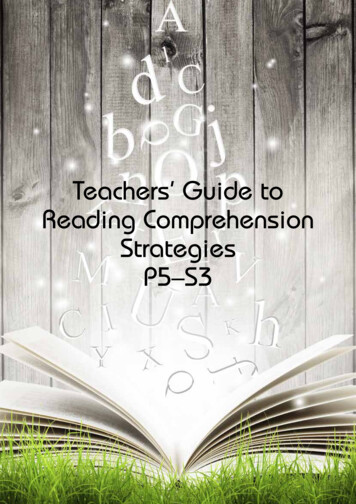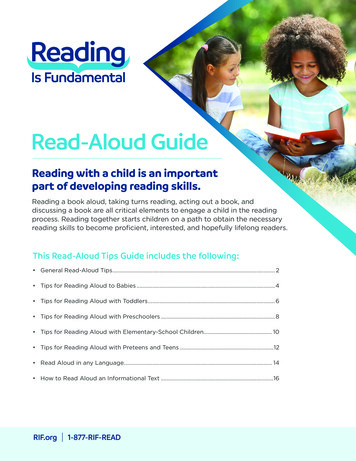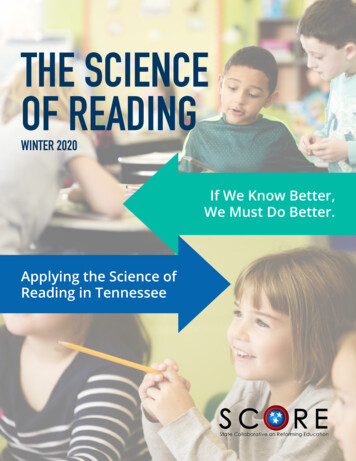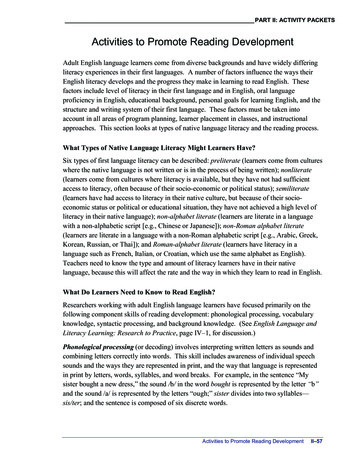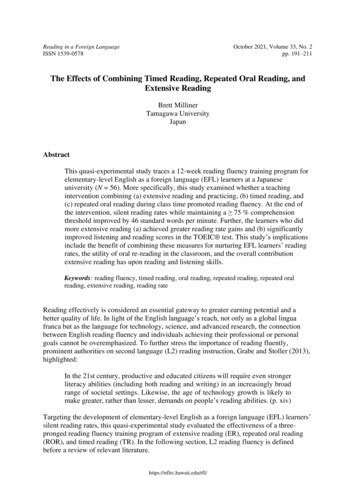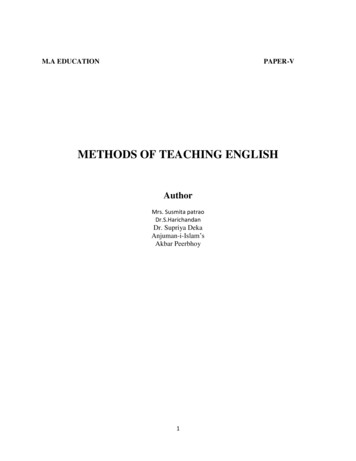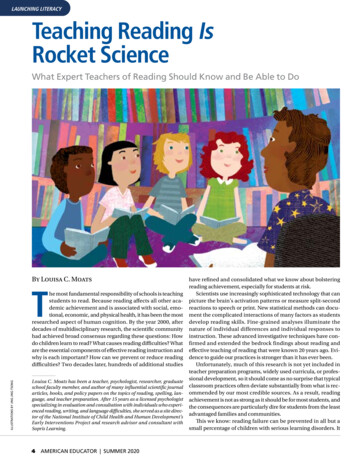
Transcription
LAUNCHING LITERACYTeaching Reading IsRocket ScienceWhat Expert Teachers of Reading Should Know and Be Able to DoBy Louisa C. MoatsTILLUSTRATIONS BY JING JING TSONGhe most fundamental responsibility of schools is teachingstudents to read. Because reading affects all other academic achievement and is associated with social, emotional, economic, and physical health, it has been the mostresearched aspect of human cognition. By the year 2000, afterdecades of multidisciplinary research, the scientific communityhad achieved broad consensus regarding these questions: Howdo children learn to read? What causes reading difficulties? Whatare the essential components of effective reading instruction andwhy is each important? How can we prevent or reduce readingdifficulties? Two decades later, hundreds of additional studiesLouisa C. Moats has been a teacher, psychologist, researcher, graduateschool faculty member, and author of many influential scientific journalarticles, books, and policy papers on the topics of reading, spelling, language, and teacher preparation. After 15 years as a licensed psychologistspecializing in evaluation and consultation with individuals who experienced reading, writing, and language difficulties, she served as a site director of the National Institute of Child Health and Human Development’sEarly Interventions Project and research advisor and consultant withSopris Learning.4AMERICAN EDUCATOR SUMMER 2020have refined and consolidated what we know about bolsteringreading achievement, especially for students at risk.Scientists use increasingly sophisticated technology that canpicture the brain’s activation patterns or measure split-secondreactions to speech or print. New statistical methods can document the complicated interactions of many factors as studentsdevelop reading skills. Fine-grained analyses illuminate thenature of individual differences and individual responses toinstruction. These advanced investigative techniques have confirmed and extended the bedrock findings about reading andeffective teaching of reading that were known 20 years ago. Evidence to guide our practices is stronger than it has ever been.Unfortunately, much of this research is not yet included inteacher preparation programs, widely used curricula, or professional development, so it should come as no surprise that typicalclassroom practices often deviate substantially from what is recommended by our most credible sources. As a result, readingachievement is not as strong as it should be for most students, andthe consequences are particularly dire for students from the leastadvantaged families and communities.This we know: reading failure can be prevented in all but asmall percentage of children with serious learning disorders. It
Policies and systems currently impacting how reading is taughtneed to improve—dramatically and rapidly.is possible to teach most students how to read if we startearly and follow the significantbody of research showing whichpractices are most effective. Students living in poverty, studentsof color, and students who areeligible for remedial servicescan become competent readers—at any age. Persistent “gaps”between more advantaged andless advantaged students can be narrowed and even closed.Fundamentally, these gaps are the result of differences in students’ opportunities to learn—not their learning abilities.Although educators have long understood the importance ofliteracy, teaching children to read is very complex. Far too manychildren have trouble reading and writing. About 20 percent ofelementary school students nationwide have serious problemslearning to read; at least another 20 percent are at risk for notmeeting grade-level expectations.1 For children growing up inunderresourced communities and attending underresourcedschools, the incidence of reading failure is astronomical and completely unacceptable. Students who are African American, Hispanic, learning English, and/or from impoverished homes fallbehind and stay behind in far greater proportion than studentswho are white and middle class. The rate of weak reading skills inthese groups is 60–70 percent, according to the National Assessment of Educational Progress.2The tragedy here is that most reading failure is unnecessary.We now know that classroom teaching itself, when it includes arange of research-based components and practices, can preventand mitigate reading difficulty. Although home factors do influence how well and how soon students read, informed classroominstruction that targets specific language, cognitive, and readingskills beginning in kindergarten enhances success for all but avery small percentage of students with learning disabilities orsevere dyslexia. Researchers now estimate that 95 percent of allchildren can be taught to read by the end of first grade, withfuture achievement constrained* only by students’ reasoningand listening comprehension abilities.3While parents, tutors, and the community can contribute toreading success, classroom instruction is the critical factor inpreventing reading problems and must be the primary focus forchange.4 To be clear: although the day-to-day work is teachers’responsibility, students’ reading success is our shared responsibility. From preparation programs to standards and assessments tocurricula and professional development, the policies and systems*It is important to note that students’ reasoning and comprehension abilities can alsobe enhanced through informed instruction. As students’ subject-matter knowledgeand vocabulary grow, so will their capacity to think critically.currently impacting how reading is taught need to improve—dramatically and rapidly. Teaching reading is rocket science. But it isalso established science, with clear, specific, practical instructional strategies that all teachers should be taught and supportedin using.Research-Validated Ideas for InstructionA well-validated concept that should underpin the design ofinstruction is called the Simple View of Reading.5 It states thatreading comprehension is the product of word recognition andlanguage comprehension. Without strong skills in either domain,an individual’s reading comprehension will be compromised.A reader’s recognition of printed words must be accurate andautomatic to support comprehension. The development of automatic word recognition depends on intact, proficient phonemeawareness, knowledge of sound-symbol (phoneme-grapheme)correspondences, recognition of print patterns such as recurringletter sequences and syllable spellings, and recognition of meaningful parts of words (morphemes).6 Young readers progress bygradually learning each of these ways that our print systemrepresents language, and then applying what they know duringample practice with both oral and silent reading. If reading skillis developing successfully, word recognition gradually becomesThis article is an excerpt of Teaching Reading Is RocketScience, 2020: What Expert Teachers of Reading ShouldKnow and Be Able to Do, which emerged from a collaboration between the American Federation of Teachers and theCenter for Development and Learning.In this report, Louisa C. Moats calls for teacher preparation and professional development to be more rigorous andbetter aligned with decades of reading science. She describesthe knowledge that undergirds successful instruction andconcludes with recommendations for the professionalpreparation of all teachers ofreading. It is our nation’sdedicated teachers and theirexcellent teaching that willbring the rocket science thatTeaching Readingis research-based readingIs Rocket Science,instruction to classrooms2020across the country and willunlock the power and joy ofreading for our children.Teachers, administrators,What ExpertTeachers ofprofessors, and district andReading ShouldKnow and Bestate leaders are encouragedAble to Doto read the full report byvisiting www.aft.org/sites/default/files/Moats.pdf.By Louisa C. MoatsAMERICAN EDUCATOR SUMMER 20205
Persistent “gaps” between more advantaged and less advantagedstudents are the result of differences in students’ opportunities to learn.so fast that it seems as if we are reading “by sight.” The path tothat end, however, requires knowing how print representssounds, syllables, and meaningful word parts; for most students,developing that body of knowledge requires explicit instructionand practice over several grades.7 While some students seem tofigure out how the print system works through incidental exposure, most do not.Language comprehension, the other essential domain thatunderlies reading comprehension, depends on backgroundknowledge, vocabulary, ability to decipher formal and complexsentence patterns, and recognition of the devices that hold a texttogether.8 Furthermore, language comprehension is facilitatedby metacognitive skills such as monitoring whether reading ismaking sense and choosing to act if it does not. The languagecomprehension factor in overall reading achievement becomesmore and more important from about fourth grade onward.9From preschool through high school, students gain vital exposure to a variety of text forms, language patterns, backgroundknowledge, and vocabulary both by listening to text read aloudand by reading itself.The implications of the Simple View of Reading should be selfevident: reading and language arts instruction must includedeliberate, systematic, and explicit teaching of word recognitionand must develop students’ subject-matter knowledge, vocabulary, sentence comprehension, and familiarity with the languagein written texts. Each of these larger skill domains depends on theintegrity of its subskills.Learning to read is a complex achievement, and learning toteach reading requires extensive knowledge and skills across thecomponents of word recognition, language comprehension,spelling, and writing. Consider what the classroom demands of6AMERICAN EDUCATOR SUMMER 2020the teacher. Children’s interest in reading must be stimulatedthrough regular exposure to interesting books and through discussions in which students respond to many kinds of texts. For bestresults, the teacher must instruct the majority of students directly,systematically, and explicitly to decipher words in print, all thewhile keeping in mind the ultimate purpose of reading, which isto learn, enjoy, and understand. To accommodate children’s variability, the teacher must assess children and tailor lessons toindividuals or groups. This includes interpreting errors, givingcorrective feedback, selecting examples to illustrate concepts,explaining new ideas in several ways, and connecting word recognition instruction to meaningful reading and writing.Some children learn language concepts and their applicationvery easily in spite of incidental teaching, but others never learnunless they are taught in an organized, systematic, efficient wayby a knowledgeable teacher using a well-designed instructionalapproach. Children of average ability might learn enough aboutreading to get by if their instruction is haphazard; with systematicresearch-based instruction, those students could achieve muchmore, such as the appreciation for language structure that supports learning words from context, perceiving subtle differencesin meaning, or refining language use.Toward a Curriculum on the Science of ReadingA core curriculum on effective literacy instruction for pre-serviceand in-service teacher education would, of course, be supplemented and honed over time, but its goal is to bring continuity,consistency, quality, and comprehensiveness to the many different programs, organizations, and systems through whichaspiring and current teachers receive information about how toteach reading. Given the current science of reading, this coreshould be divided roughly into the following four areas:1. Knowing the basics of reading psychology and development;2. Understanding language structure for both word recognitionand language comprehension;3. Applying best practices in all components of reading instruction; and4. Using validated, reliable, efficient assessments to inform classroom teaching.This excerpt offers an introduction to the first two areas. For adetailed discussion of all four areas, please see the full . Reading Psychology and DevelopmentLearning to read is not natural or easy for most children. Unlikespoken language, which is learned with almost any kind of contextual exposure, reading is an acquired skill. Although surrounding children with books will support reading development, and a“literature-rich environment” is highly desirable, it is not sufficient for learning to read. Neither will exposure to print ordinarily
A reader’s recognition of printed words must be accurate andautomatic to support comprehension.be sufficient for learning to spell, unless organized practice isprovided. Thus, teachers must be reflective, knowledgeable, andintentional about the content they are teaching—that is, the symbol system (orthography) itself and its relationship to meaning.Good readers do not skim and sample the text when they scana line in a book. They process the letters of each word in detail,although they do so very rapidly and unconsciously. Those whocomprehend well accomplish letter-wise text scanning with relative ease and fluency. When word identification is fast and accurate, a reader has ample mental energy to think over the meaningof the text. Knowledge of sound-symbol mapping is crucial indeveloping word recognition: the ability to sound out and recognize words accounts for about 80 percent of the variance in firstgrade reading comprehension and continues to be a major (albeitdiminishing) factor in text comprehension as students progressthrough the grades (and students’ background knowledge andvocabulary become ever-larger factors in comprehending academic texts).11The ability to sound out words is, in fact, a major underpinningthat allows rapid recognition of words. (This recognition is so fastthat some people mistakenly believe it is happening “by sight.”)Before children can easily sound out or decode words, they musthave at least an implicit awareness of the speech sounds that arerepresented by symbolic units (letters and their combinations).Children who learn to read well are sensitive to linguistic structure, recognize redundant patterns, and connect letter patternswith sounds, syllables, and meaningful word parts quickly, accurately, and unconsciously. Effective teaching of reading entailsthese concepts, presenting them in a sequence from simple andconsistent to complex and variable.The word-recognition component of reading is most closelydependent on the phonological aspect of language processing.12Phonological language skills include awareness of bits of speechor linguistic elements within words: consonant and vowel phonemes, spoken syllables, grammatical endings, and meaningfulword parts (morphemes). Awareness of these linguistic elementsin spoken language is essential for making sense of print becauseour alphabetic writing system represents language at all theselevels. When students cannot rapidly associate the sounds, syllables, and/or morphemes in spoken words with printed symbols,they will not be able to store words in their mental dictionaries.Conversely, a new word that is decoded accurately through phonological analysis can be pronounced and remembered, even ifits meaning is not yet known.Beginning reading instruction of necessity will focus onteaching students how to read and write words, following a systematic and logical sequence. When appropriate, the emphasiswill shift to increasing reading volume. Combining research onreading, cognitive science related to the role of knowledge inthinking, and practice-basedwisdom, it appears that opportunities for wide reading arebest provided within a knowledge-building curriculum inwhich text readings are linkedby a theme or topic.13 Ironically,while background knowledgecan be gained from reading, it isalso true that those who alreadyknow more about a topic makeUsing the Science of Reading to Shed Light on Myths and MisconceptionsTeachers are often not in a position tomake decisions regarding school districtreading curricula and/or reading texts.Nevertheless, teachers who understandthe foundations of reading psychologyand development will be better preparedto argue against the adoption ofirresponsible fads and countermand theproliferation of appealing but unsupported ideas. Examples of enduring mythsand misconceptions that are embedded inpopular programs, articles, and textbooks10 include: reading instruction is only neededuntil third grade; competent teachers do not usepublished reading programs; avoiding published reading programsempowers teachers and enhances theprofessional status of teaching; teaching phonics, word attack, andspelling skills directly to children isharmful; reading a lot is the best way toovercome a reading problem; children should be taught to guesswords on the basis of meaning andsyntax; and skills must always be taught in thecontext of literature.With no accountability system tocheck their dissemination, unsupportedideas such as these fill the void left byweak pre-service and in-service programs.Perhaps the dubious quality of pasteducational research has justified theprevalent cynicism among educators,who are often told that research exists tosupport any point of view. However,reading is actually one of the moststudied aspects of human behavior, and alarge body of work based on soundprinciples of objective inquiry exists thatcould be informing the field. Convergingfindings from multiple studies, like thosesummarized in this article, should drivethe profession.–L. C. M.AMERICAN EDUCATOR SUMMER 20207
Learning to teach reading requires extensive knowledge and skills ofword recognition, language comprehension, spelling, and writing.better inferences and retain meanings better than those whoknow little about it. Therefore, reading practice should be linkedto or embedded within the study of subjects including science,history, literature, and the arts. Interpretive strategies that facilitate comprehension—including summarizing, questioning,predicting outcomes, and monitoring one’s own understanding—are best used in the service of learning defined curricularcontent.14 Moreover, writing in response to reading is one of thebest ways to enhance reading comprehension.152. Language StructureExpert teaching of reading requires knowledge of languagestructure at all levels.16 Without such knowledge, teachers arenot able to respond insightfully to student errors, choose exam-Examples of Knowledge of Language Structure and Their Application to TeachingSelected Concepts and Skills by Domain1. Phonetics and PhonologyUnderstand that speech sounds are not letters, and letters do not make sounds—they represent them.Know that consonant and vowel phonemes can be grouped into classeswith similar properties (e.g., stops, nasals, etc.).Instead of asking “What sound does each letter make?,” use accuratelanguage and focus on a specific sound, asking, “What letter(s) represent/er/ in first?”Help children focus on sounds by saying things like, “/m/, /n/, and /ng/ arethe three ‘nosey’ sounds in English; hold your nose to feel how thesesounds go through the nose.”2. Phoneme AwarenessProduce speech sounds accurately during reading, vocabulary, and spellinginstruction.Say /t/ crisply, not tuh.Identify, match, and select appropriate examples of words containingspecific phonemes.In teaching awareness of the phoneme /sh/, use words including shoe, chef, andsugar. (Listen for the sound; don’t confuse the task with spelling or phonics.)3. MorphologyIdentify morphemes (the smallest meaningful units of language) anddistinguish them from syllables.The word interchangeable has five syllables and three morphemes: inter,change, able.Recognize that spellings of morphemes are often stable even whenpronunciation varies in words with a common root; as a result, spelling canbe a clue to meaning.4. OrthographyUnderstand that letters and letter combinations (graphemes) representsounds but are not the same as sounds.Use a comprehensive scope and sequence that includes instruction indigraphs, blends, silent letter combinations, vowel teams, diphthongs, andthe six common syllable types.5. SemanticsTeach word meanings in relation to other word meanings.Adopt a routine for teaching unfamiliar word meanings to students.8Ideas for Application to InstructionExpress, expression; legal, legislate; inspire, inspiration; nature, natural.The phoneme /f/ is represented by f, ff (stuff), gh (tough), and ph (phone).Explicit instruction in the written code should extend at least throughgrade 3 when syllables and morphemes in longer words are tackled.Include antonyms, synonyms, associations, analogies, and categoricalrelationships on vocabulary tasks.Provide a student-friendly definition, many examples, and opportunitiesfor students to say and use new words.6. Syntax and Text StructureAppreciate that texts have structures that can be represented with graphicorganizers (e.g., narrative and informational texts organized as compare/contrast, argumentation, description, cause/effect, etc.).Identify and illustrate for students the purpose of a given text and itslogical structure.Identify cohesive devices such as pronoun references, connecting words,word substitutions, parallel sentence structure, and paragraph organization.Help students identify how a text hangs together and how to follow theconnections among ideas as meaning is constructed.AMERICAN EDUCATOR SUMMER 2020
Reading practice should be linked to or embedded within the study ofsubjects including science, history, literature, and the arts.teacher and practiced overtly if students are not comprehendingwell or if they approach reading comprehension passively. Vocabulary is best taught with a variety of complementary methods, bothdirect and incidental, designed to explore the relationships amongwords and the relationships among word structure, origin, andmeaning. Of course, children also benefit from access to full libraries and incentives to read independently.The fact that teachers need better preparation, professionaldevelopment, and resources to carry out deliberate instruction inreading, spelling, and writing should prompt action rather thancriticism. It should highlight the chronic gap between what teachersneed and what they have been given. Just about all children can betaught to read and deserve no less from their teachers. Teachers, inturn, deserve no less than the knowledge, skills, and supportedpractice that will enable their teaching to succeed. There is no moreimportant challenge for education to undertake. Endnotesples for concepts, explain and contrast words and their parts, orjudge what focus is needed in a lesson. The table on page 8 provides examples of key concepts of language structure and howthey apply to instruction.Experts agree that children who initially are at risk for failure are saved, in most cases, by instruction that directlyteaches the specific foundational language skills onwhich proficient reading depends.17 Effective teachers ofreading raise awareness and proficiency through every layer oflanguage organization, including sounds, syllables, meaningfulparts (morphemes), phrases, sentences, paragraphs, and variousgenres of text. Their teaching strategies are explicit, systematic,and engaging.18 They also balance language skill instruction withits application to purposeful daily writing and reading, no matterwhat the skill level of the learner. Middle- and upper-grade children who are weak readers can be brought up to grade level withappropriate instruction (although the time, effort, and emotional strain for children and teachers involved is considerablygreater than that required to teach younger children, so offeringresearch-based instruction in the early grades must remain atop priority).A rich and meaningful curriculum, in which students areexposed to a variety of texts as they learn concepts in science, literature, social studies, history, the arts, and culture, should providethe context for developing reading and writing skills. Comprehension strategies should not be taught in isolation but used as necessary to enhance understanding of text assigned for content learning.Useful comprehension strategies to embed in content readinginclude prediction of outcomes, summarizing, clarification, questioning, and visualization; these can be modeled explicitly by the1. R. H. Good, D. C. Simmons, and E. Kame’enui, “The Importance and Decision-MakingUtility of a Continuum of Fluency-Based Indicators of Foundational Reading Skills forThird-Grade High-Stakes Outcomes,” Scientific Studies of Reading 5 (2001): 257–288; andNational Assessment of Educational Progress, “Nation’s Report Card: How Did U.S. StudentsPerform on the Most Recent Assessments?,” U.S. Department of Education, National Centerfor Education Statistics, www.nationsreportcard.gov.2. National Assessment of Educational Progress, “Nation’s Report Card.”3. D. A. Kilpatrick, Essentials of Assessing, Preventing, and Overcoming Reading Difficulties(Hoboken, NJ: Wiley, 2015); L. Lim et al., “Using the MULTILIT Literacy Instruction Programwith Children Who Have Down Syndrome,” Reading and Writing 32 (2019): 2179–2200; P.G. Mathes et al., “The Effects of Theoretically Different Instruction and Student Characteristics on the Skills of Struggling Readers,” Reading Research Quarterly 40 (2005): 148–182;and J. K. Torgesen, “Avoiding the Devastating Downward Spiral: The Evidence That EarlyIntervention Prevents Reading Failure,” American Educator 28, no. 3 (2004): 6–9, 12–13,17–19, 45–47.4. B. Foorman et al., Foundational Skills to Support Reading for Understanding inKindergarten through 3rd Grade (Washington, DC: National Center for EducationalEvaluation and Regional Assistance, 2016), https://whatworks.ed.gov; and B. Foorman et al.,“The Impact of Instructional Practices in Grades 1 and 2 on Reading and SpellingAchievement in High Poverty Schools,” Contemporary Educational Psychology 31 (2006):1–29.5. H. W. Catts, S. M. Adlof, and S. E. Weismer, “Language Deficits in Poor Comprehenders: ACase for the Simple View of Reading,” Journal of Speech, Language, and Hearing Research49, no. 2 (2006): 278–293; and P. Gough and W. E. Tunmer, “Decoding, Reading, andReading Disability,” Remedial and Special Education 7, no. 1 (1986): 6–10.6. L. Ehri, “Orthographic Mapping in the Acquisition of Sight Word Reading, SpellingMemory, and Vocabulary Learning,” Scientific Studies of Reading 18 (2014): 5–21; andKilpatrick, Essentials of Assessing.7. L. Ehri et al., “Systematic Phonics Instruction Helps Students Learn to Read: Evidence fromthe National Reading Panel’s Meta-Analysis,” Review of Educational Research 71 (2001):393–447.8. K. Cain and J. Oakhill, eds., Children’s Comprehension Problems in Oral and WrittenLanguage: A Cognitive Perspective (New York: Guilford, 2007); K. Nation, “Children’sReading Comprehension Difficulties,” in The Science of Reading: A Handbook, ed. M. J.Snowling and C. Hulme (Oxford, UK: Blackwell, 2005), 248–266; and J. Oakhill, K. Cain, andC. Elbro, Understanding and Teaching Reading Comprehension: A Handbook (New York:Routledge, 2015).9. F. R. Vellutino et al., “Components of Reading Ability: Multivariate Evidence for aConvergent Skills Model of Reading Development,” Scientific Studies of Reading 11, no. 1(2007): 3–32.10. R. Allington, “What Really Matters When Working with Struggling Readers,” TheReading Teacher 66, no. 7 (2013): 520–530; and F. Smith, Unspeakable Acts, UnnaturalPractices: Flaws and Fallacies in “Scientific” Reading Instruction (Portsmouth, NH:Heinemann, 2003).11. C. Schatschneider et al., “Kindergarten Prediction of Reading Skills: A LongitudinalComparative Analysis,” Journal of Educational Psychology 96 (2004): 265–282; and Vellutinoet al., “Components of Reading Ability.”(Continued on page 39)AMERICAN EDUCATOR SUMMER 20209
Teaching Reading Is Rocket Science(Continued from page 9)12. S. Brady, “Efficacy of Phonics Teaching for ReadingOutcomes: Implications from Post-NRP Research,” in ExplainingIndividual Differences in Reading, ed. S. Brady, D. Braze, and C.Fowlers (London: Psychology Press, 2011), 69–96; S. Brady,“The 2003 IDA Definition of Dyslexia: A Call for Changes,”Perspectives on Language and Literacy 45, no. 1 (2019): 15–21;A. Kjeldsen et al., “Gains from Training in PhonologicalAwareness in Kindergarten Predict Reading Comprehension inGrade 9,” Scientific Studies of Reading 18, no. 6 (2014):452–468; I. Y. Liberman, D. Shankweiler, and A. M. Liberman,“The Alphabetic Principle and Learning to Read,” in Phonologyand Reading Disability: Solving the Reading Puzzle, ed. D.Shankweiler and A. Liberman (Ann Arbor, MI: University ofMichigan Press, 1989); and H. S. Scarborough and S. A. Brady,“Toward a Common Terminology for Talking about Speech andReading: A Glossary of ‘Phon’ Words and Some RelatedTerms,” Journal of Literacy Research 34, no. 3 (2002): 299–336.13. E. D. Hirsch, Why Knowledge Matters: Rescuing OurChildren from Failed Educational Theories (Cambridge, MA:Harvard Education Press, 2016); and N. Wexler, TheKnowledge Gap: The Hidden Cause of America’s BrokenEducation System—and How to Fix It (New York: PenguinRandom House, 2019).14. D. T. Willingham, “The Usefulness of Brief Instruction inReading Comprehension Strategies,” American Educator 30,no. 4 (Winter 2006–2007): 39–50.15. S. Graham and M. Herbert, Writing to Read: Evidencefor How Writing Can Improve Reading (Washington, DC:Alliance for Excellent Education, 2010).16. L. C. Moats, Speech to Print: Language Essentials forTeachers (Baltimore, MD: Brookes Publishing, 2020); C.Snow, P. Griffin, and S. Burns, Knowledge to SupportTeaching of Reading: Preparing Teachers for a ChangingWorl
represents language, and then applying what they know during ample practice with both oral and silent reading. If reading skill is developing successfully, word recognition gradually becomes This article is an excerpt of Teaching Reading Is Roc



